UPSC Exam > UPSC Notes > Famous Books for UPSC Exam (Summary & Tests) > Harappan Civilization - 1
Harappan Civilization - 1 | Famous Books for UPSC Exam (Summary & Tests) PDF Download
| Table of contents |

|
| Introduction |

|
| Origin and Extent |

|
| Cities of Indus Valley Civilization |

|
| Town Planning |

|
| Economic Activities |

|
Introduction
- Harappan civilization, also known as the Indus Valley civilization, discovered between 1920 and 1922 during excavation of two significant sites: Harappa (Ravi River) and Mohenjodaro (Indus River).
- D.R. Sahani excavated Harappa, while R.D. Bannerji excavated Mohenjodaro.
- Dates back to 2600 BC to 1900 BC, making it one of the oldest civilizations globally.
- Originally referred to as Indus Valley civilization, now commonly called Harappan civilization due to Harappa being the first site.
- Recent discoveries suggest the civilization extended beyond the Indus Valley.
- Considered India's first urban culture, developed alongside Mesopotamia and Egypt.
- Relies solely on archaeological excavations for understanding Harappan people's life and culture, as the script remains undeciphered.
- Gradual evolution from earlier Neolithic village cultures.
- Advanced technology for harnessing fertile plains of the Indus River led to increased agricultural production.
- Surplus supported non-agricultural populations, including artisans and administrators.
- Increased production enabled trade and exchange with distant regions, bringing prosperity and establishing cities.
- Around 2000 BC, several regional cultures emerged in different parts of the subcontinent, primarily based on the use of stone and copper tools.
- These are referred to as Chalcolithic cultures.
- They were located outside the Harappan region.
- These non-Harappan Chalcolithic cultures were not as affluent or prosperous and had a rural nature in contrast to the urban Harappan civilization.
- The origin and development of these cultures spanned approximately 2000 BC to 700 BC.
- These cultures are primarily found in Western and Central India.
Origin and Extent
- The Harappan civilization, also known as the Indus Valley Civilization, can be divided into three distinct phases:
- Early Harappan phase (3500 BC–2600 BC) characterized by small villages, simple town planning, and developing trade and crafts.
- Mature Harappan phase (2600 BC–1900 BC) marked by well-developed towns, advanced brick structures, and extensive trade.
- Late Harappan phase (1900 BC–1400 BC) saw a decline in urban traits, abandoned cities, and the disappearance of trade.
- The geographical extent of the Harappan civilization encompassed parts of present-day India (including Rajasthan, Punjab, Haryana, Gujarat, Maharashtra, and Western Uttar Pradesh), regions of Pakistan, and Afghanistan.
Question for Harappan Civilization - 1Try yourself:Which of the following is NOT one of the three phases of the Harappan civilization?
View Solution
Cities of Indus Valley Civilization
- Key sites of the civilization included Manda in Jammu and Kashmir, Shortughai in Afghanistan, Harappa in Western Punjab (Pakistan), Mohenjodaro and Chanhudaro in Sind, Kalibangan in Rajasthan, Lothal and Dholavira in Gujarat, Banawali and Rakhigarhi in Haryana, Daimabad in Maharashtra, Sutkagendor on the Makran Coast (near the Pakistan-Iran border), and Alamgirpur in western Uttar Pradesh.
- Settlements in the Harappan civilization were mainly concentrated around the Harappa, Kalibangan, and Mohenjodaro regions, considered the heartland of the civilization.
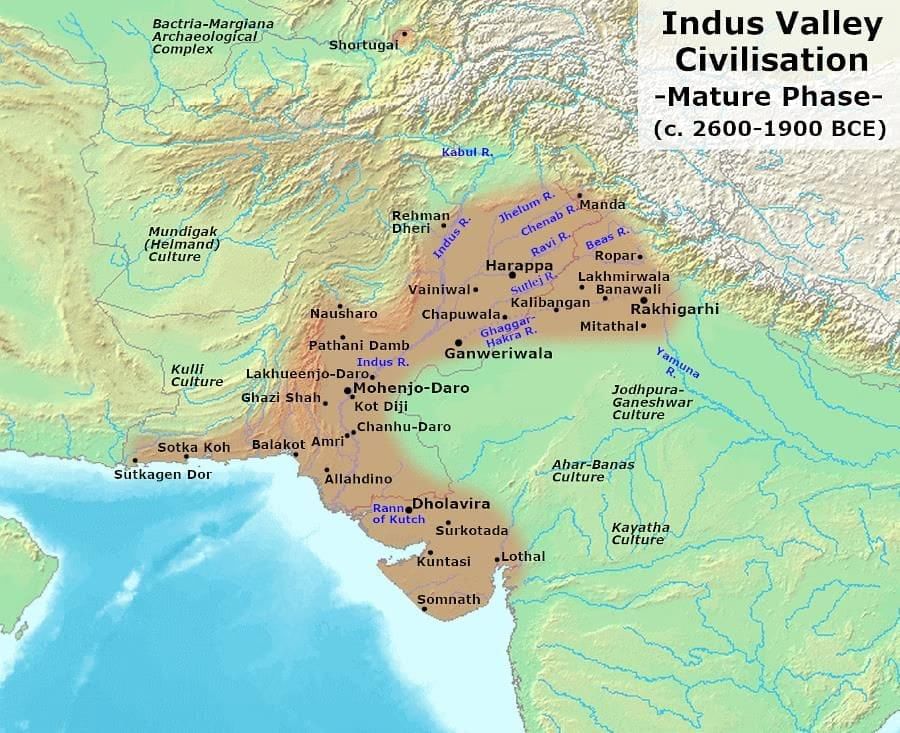 Indus Valley Cities
Indus Valley Cities
- These areas shared similar geographical features like flat land, dependence on monsoons and Himalayan rivers for water supply, and an agro-pastoral economy.
- Urbanization in the Harappan culture was marked by well-planned cities, specialized arts and crafts, trade, taxation, and the use of a script.
- In addition to the urban settlements, there were also many smaller sites inhabited by primitive communities of hunter-gatherers or pastoral nomads that coexisted with the Harappan civilization. Some of these sites served as ports or trading outposts.
- The Harappan civilization is considered an urban culture due to its distinct features, such as well-planned cities, specialized arts and crafts, trade, taxation, and the use of a script.
Town Planning
- Town-planning in the Harappan civilization is highly remarkable for its significant uniformity, with some minor regional variations.
- This uniformity can be observed in various aspects, such as the layout of towns, streets, structures, brick sizes, and drainage systems.
- Major sites, including Harappa, Mohenjodaro, and Kalibangan, feature a similar design, with a citadel on a higher mound in the west and a lower town on the eastern side of the settlements.
- The citadel comprises large structures believed to have served as administrative or ritual centers, while residential buildings are located in the lower town.
- The streets are designed in a grid pattern, intersecting at right angles, dividing the city into several residential blocks. Narrow lanes connect the main streets, and the doors of the houses open into these lanes rather than the main streets.
- The size of the houses varies, ranging from single-room houses in Harappa to larger structures.
- These houses, primarily built of burnt bricks, indicate differences in the social status of their inhabitants.
- Larger houses with multiple rooms surrounding a square courtyard, private wells, kitchens, and bathing platforms likely belonged to the wealthy.
- Smaller one-room buildings or barracks were likely meant for the poorer sections of society.
- The Harappan civilization's drainage system was well-developed and efficient.
- Every house was equipped with drains that connected to the street drains, which were covered with manholes.
- Bricks or stone slabs that could be removed for cleaning purposes were placed at regular intervals alongside the streets, demonstrating the inhabitants' strong understanding of sanitation principles.
Some Major Structural Remains of the Harappan Towns:
- Mohenjodaro features significant architectural remains, with the "Great Bath" being the most prominent structure.
- The "Great Bath" is a large public bathing area encircled by corridors and accessible via staircases on the north and south ends.
- To prevent water leakage, a thin layer of bitumen was applied to the base of the bath, and a nearby well supplied water.
- A drainage system for water disposal was also present, and rooms surrounding the bath were likely used for changing clothes.
- Scholars believe that the "Great Bath" was primarily used for ritual bathing.
 Great Bath of Mohenjodaro
Great Bath of Mohenjodaro
- Another notable structure in Mohenjodaro is the granary, located to the west of the "Great Bath."
- This structure comprises several brick blocks used for grain storage.
- A similar granary has been discovered in Harappa, where rows of circular brick platforms were used for threshing grains, as evidenced by the remains of wheat and barley chaff found at the site.
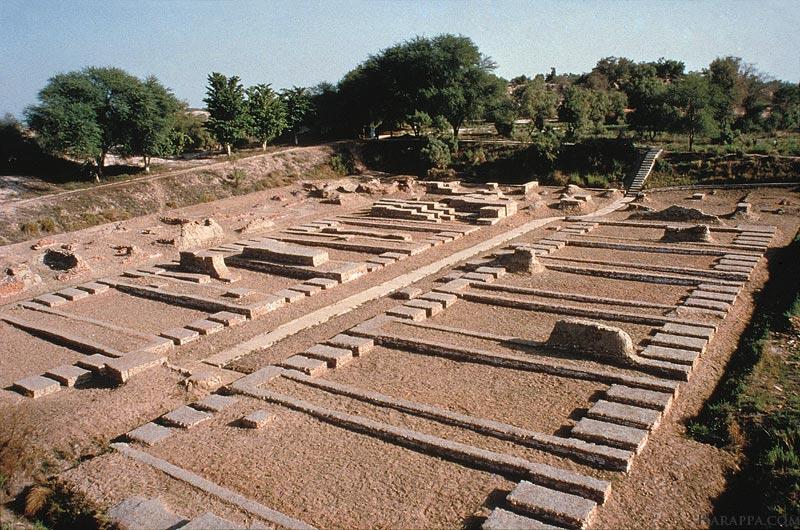 Granary at Harappa
Granary at Harappa
- In Lothal, a brick structure has been identified as a dockyard built for docking ships and handling cargo.
1. This finding indicates that Lothal was a significant port and trading hub for the Harappan civilization.
 Dockyard at Lothal
Dockyard at Lothal
Economic Activities
(i) Agriculture- The economic success of the Harappan civilization was primarily due to thriving activities such as agriculture, arts and crafts, and trade.
- The fertile Indus alluvium played a significant role in surplus agricultural production, enabling the Harappan people to engage in internal and external exchanges and develop various crafts and industries.
- Agriculture and pastoralism (raising livestock) formed the foundation of the Harappan economy.
- Granaries discovered at sites like Harappa, Mohenjodaro, and Lothal were used to store grain.
- While there is no definitive evidence of the specific tools used for agriculture, furrows or plough marks found in a field at Kalibangan suggest that plough cultivation was practiced. A terracotta plough has also been reported at Banawali in the Hissar district of Haryana.
- Irrigation systems were relatively small-scale, relying on wells or diverting river water through channels.
- The main food crops grown by the Harappan people included wheat, barley, sesame, mustard, peas, and jujube.
- Rice has also been found at Lothal and Rangpur, in the form of husks embedded in pottery.
- Another important crop was cotton, evidenced by a piece of woven cloth discovered at Mohenjodaro.
- In addition to these crops, the Harappan diet also consisted of fish and animal meat.
(ii) Industries and Crafts
- The Harappan civilization had knowledge of various metals, except for iron.
- They created objects from gold and silver, such as beads, armlets, needles, and other ornaments. Silver was more commonly used than gold.
- Copper tools and weapons were prevalent, including axes, saws, chisels, knives, spearheads, and arrowheads.
- Interestingly, the weapons produced by the Harappans were primarily defensive, as there is no evidence of offensive weapons like swords.
- Stone tools were widely used alongside metal tools.
- Copper was primarily sourced from Khetri in Rajasthan, gold from the Himalayan riverbeds and South India, and silver from Mesopotamia.
- There is also evidence of limited use of bronze, with the most famous example being the bronze 'dancing girl' figurine found at Mohenjodaro. This is a nude female figure in a dancing pose adorned with numerous bangles.
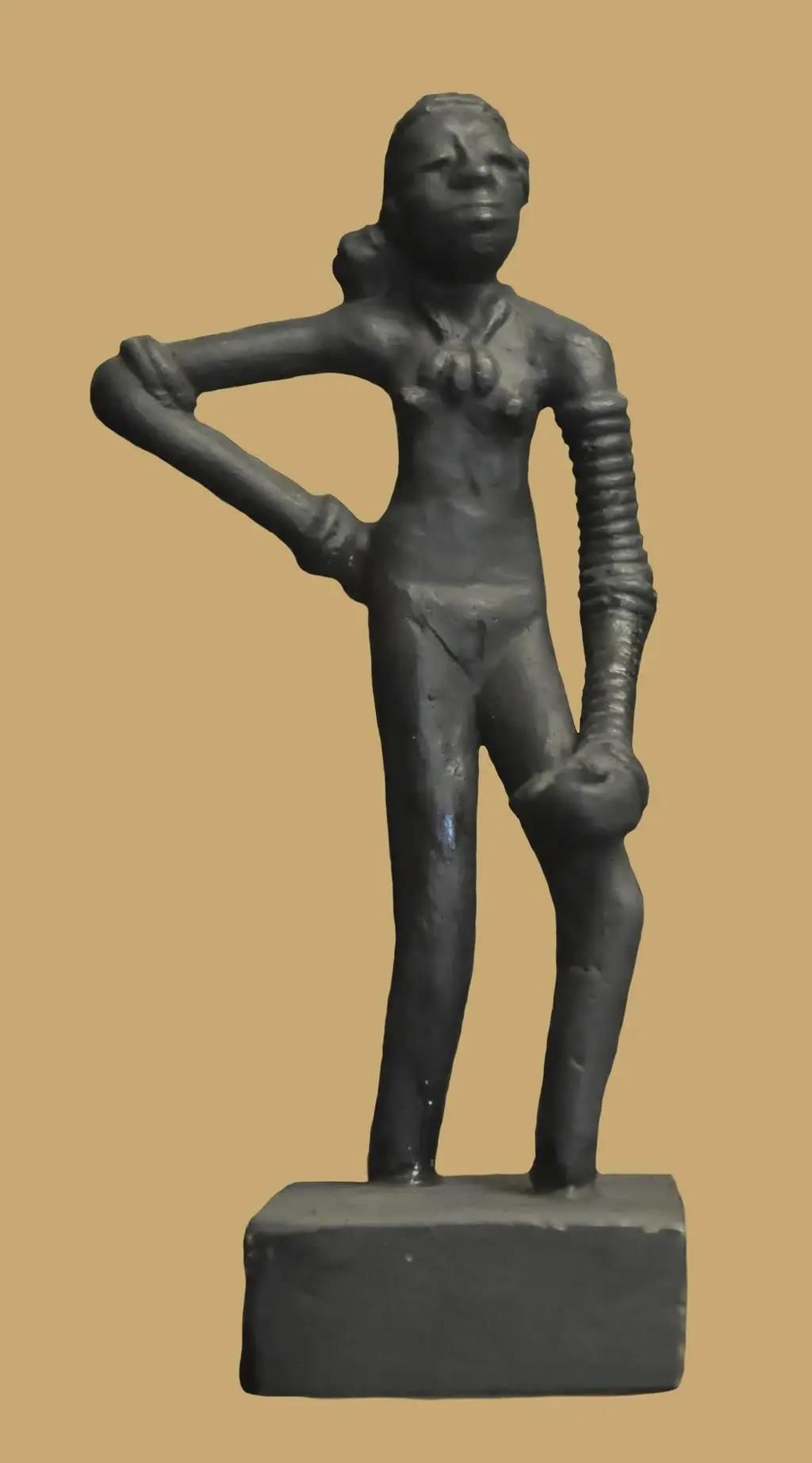 Dancing Girl
Dancing Girl - Bead-making was a significant craft, with beads made from precious and semi-precious stones like agate, carnelian, and steatite.
- Beadmakers' shops have been discovered at Chanhudaro and Lothal, along with gold and silver beads.
- Ivory carving and inlaying were also practiced, used in beads, bracelets, and other decorative items.
- Overall, the Harappans displayed exceptional skill in a wide range of arts and crafts.
- A well-known piece of Harappan art is a stone sculpture of a bearded man discovered at Mohenjodaro.
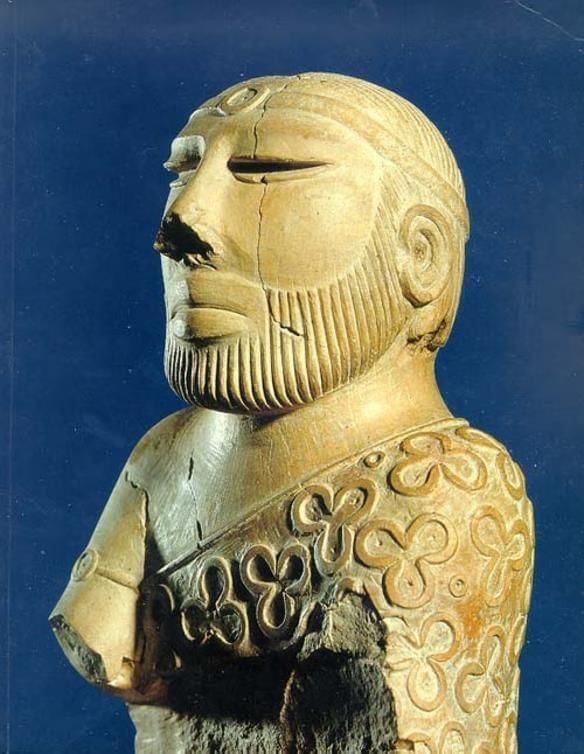 Stone Sculpture of Bearded Man
Stone Sculpture of Bearded Man
- The man's eyes are half closed, indicating a posture of meditation.
- He wears an embroidered cloak across the left shoulder.
- Some scholars believe it could be a bust of a priest.
- Terracotta figurines of males and females have been discovered from various Harappan sites.
- The female figurines outnumber those of males and are believed to represent the worship of the mother goddess.
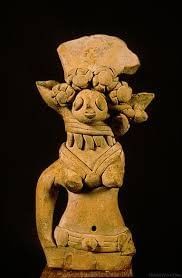 Female Figurine of Harappa
Female Figurine of Harappa
- Various models of birds, monkeys, dogs, sheep, cattle, humped and humpless bulls are found.
- Noteworthy specimens include various models of terracotta carts.
- Pottery-making was an important industry in the Harappan period.
- Wheel-made pottery was common and had a red coating with black decorations.
- Pottery came in various sizes and shapes.
- Painted designs included horizontal lines of varied thickness, leaf patterns, palm and pipal trees, and depictions of birds, fishes, and animals.
- The Harappans manufactured seals of various kinds.
- More than two thousand seals have been discovered from different sites.
- These seals were generally square in shape and made of steatite.
- Notably, while the seals depict a variety of animals, there is no representation of horses on these seals.
- The absence of horse representations on Harappan seals has led many scholars to argue that the horse was not known to the Harappan people. However, there are others who do not accept this argument.
 Harappa Seals
Harappa Seals
- Harappan seals contain some signs in the Harappan script, which, as of now, has not been deciphered.
- One of the most famous Harappan seals features a horned male deity.
- This deity is depicted with three heads and is sitting in a yogic posture.
- He is surrounded by four animals: an elephant, tiger, rhinoceros, and a buffalo.
- Many scholars identify this deity with the ancient form of the god Pashupati (Lord of Beasts), though there are others who dispute this identification.
 Seals of Pashupati
Seals of Pashupati
(iii) Trade
- The trading network of the Harappan civilization was crucial to its urban economy, encompassing both internal (within the country) and external (foreign) trade.
- The urban population relied on surrounding rural areas for essential items and food, leading to a strong village-town interdependence.
- Urban craftsmen needed markets to sell their goods, resulting in contact between different towns and even foreign lands, such as Mesopotamia.
- Various metals and precious stones were required for crafting goods, which had to be brought in from other regions, indicating exchange activities.
- Precious stones used for bead-making had to be imported from various sources.
- Lapis lazuli was sourced from the Badakshan mines in northeast Afghanistan.
- Turquoise and jade might have come from Central Asia.
- Western India supplied agate, chalcedony, and carnelian, while seashells likely came from Gujarat and neighboring coastal areas.
- High-quality timber and other forest products were perhaps obtained from northern regions such as Jammu.
- External trade with Mesopotamia was conducted primarily through Oman and Bahrain in the Persian Gulf, as evidenced by the presence of Harappan artifacts in these regions.
- A seal of West Asian or Persian origin discovered at Lothal confirms this contact.
- Mesopotamian cities, such as Susa and Ur, have yielded around two dozen Harappan seals, along with other artifacts like pottery, etched carnelian beads, and dice with Harappan features.
- Inscriptional evidence from Mesopotamia provides valuable information on Harappan contact with Mesopotamia.
- These inscriptions mention trade with Dilmun, Magan, and Meluhha.
- Scholars identify Meluhha as the Harappan region, Magan as the Makran coast, and Dilmun as Bahrain.
- Mesopotamia imported items like copper, carnelian, ivory, shell, lapis lazuli, pearls, and ebony from Meluhha, while exports to the Harappans included garments, wool, perfumes, leather products, and silver.
Question for Harappan Civilization - 1Try yourself:Which of the following was the primary base of the Harappan economy?
View Solution
Conclusion
In conclusion, the Harappan civilization, also known as the Indus Valley civilization, was one of the oldest and most advanced urban cultures in the world. It was marked by well-planned cities, advanced agriculture, thriving industries, and extensive trade networks, both internal and external. The Harappans were skilled in various arts and crafts, and their town-planning and sanitation systems were particularly remarkable. Despite the undeciphered script, the Harappan civilization's archaeological remains provide a fascinating glimpse into the life and culture of the people who once inhabited this vast region.
The document Harappan Civilization - 1 | Famous Books for UPSC Exam (Summary & Tests) is a part of the UPSC Course Famous Books for UPSC Exam (Summary & Tests).
All you need of UPSC at this link: UPSC
|
1179 videos|2219 docs|849 tests
|
FAQs on Harappan Civilization - 1 - Famous Books for UPSC Exam (Summary & Tests)
| 1. What were the key features of town planning in the Harappan Civilization? |  |
Ans. The Harappan Civilization is renowned for its advanced town planning, characterized by well-organized grid patterns, sophisticated drainage systems, and standardized brick sizes. Cities like Mohenjo-Daro and Harappa had fortified citadels, residential areas, and public baths, indicating a high level of urban infrastructure and civic planning.
| 2. What was the economic basis of the Harappan Civilization? |  |
Ans. The economy of the Harappan Civilization was primarily based on agriculture, trade, and craft production. Crops such as wheat, barley, and cotton were cultivated, while evidence of trade with neighboring regions suggests a thriving economy. Artisans produced goods like pottery, beads, and textiles, which were traded both locally and internationally.
| 3. What were the geographical boundaries of the Harappan Civilization? |  |
Ans. The Harappan Civilization, also known as the Indus Valley Civilization, extended across parts of present-day Pakistan and northwest India. It encompassed a vast area along the Indus River and its tributaries, including regions such as Punjab, Sindh, and parts of Gujarat and Rajasthan.
| 4. How did the Harappan Civilization contribute to urbanization? |  |
Ans. The Harappan Civilization laid the foundations for urbanization by developing large, planned cities with advanced infrastructure. The presence of public baths, granaries, and docks suggests a complex societal structure, where urban centers became hubs of trade, culture, and governance, influencing subsequent civilizations in the region.
| 5. What are some frequently debated theories about the decline of the Harappan Civilization? |  |
Ans. The decline of the Harappan Civilization has sparked various theories, including climate change leading to droughts, river shifts affecting agriculture, over-exploitation of resources, and possible invasions. Recent research suggests a combination of these factors may have contributed to the civilization's eventual decline rather than a single cause.
Related Searches
















